Wear Characterization and Coefficient of Friction Prediction Using a Convolutional Neural Network Model for Chromium-Coated SnSb11Cu6 Alloy
Abstract
1. Introduction
2. Materials and Methods
2.1. Fabrication
2.2. Characterization
2.3. Deep Learning-Based Predictive Modeling and Feature Importance Analysis
3. Results and Discussion
3.1. Microstructural Analysis
3.2. Microhardness and Wear Behavior
3.3. Modeling and Feature Importance Analysis
4. Conclusions
Author Contributions
Funding
Institutional Review Board Statement
Informed Consent Statement
Data Availability Statement
Acknowledgments
Conflicts of Interest
References
- Zhang, X.; Wu, S.; Liu, W.; Chu, X.; Xie, Y.; Zhang, F. High Performance Tin-Based Babbitt Coatings Deposited by High-Pressure Cold Spraying. Surf. Coat. Technol. 2023, 473, 130048. [Google Scholar] [CrossRef]
- Ramadan, M.; Alghamdi, A.S.; Subhani, T.; Halim, K.S.A. Fabrication and Characterization of Sn-Based Babbitt Alloy Nanocomposite Reinforced with Al2O3 Nanoparticles/Carbon Steel Bimetallic Material. Materials 2020, 13, 2759. [Google Scholar] [CrossRef] [PubMed]
- Luo, W.; Lin, D.; Xi, X.; Wang, Y.; Liu, Y.; Liu, D.; Chen, B.; Bian, H.; Song, Y.; Liu, F.; et al. High-Strength and Wear-Resistant Babbitt Alloy Coatings Prepared through in-Situ Alloying. Surf. Coat. Technol. 2024, 494, 131416. [Google Scholar] [CrossRef]
- Ribeiro, R.M.; Câmara, M.A. Estudo Do Comportamento Tribológico Do Par Liga Babbitt—Aço ABNT 1045 Quando Variadas a Espessura e a Rugosidade Do Revestimento. Matéria 2020, 25, e-12661. [Google Scholar] [CrossRef]
- Wang, J.; Xue, Y.; Zhang, Y.; Wang, S. Creep Mechanical Properties of Babbitt SnSb11Cu6. Xiyou Jinshu Cailiao Yu Gongcheng/Rare Met. Mater. Eng. 2015, 44, 1432–1438. [Google Scholar]
- Cheng, Z.; Wang, M.; Wang, B.; Zhang, L.; Zhu, T.; Li, N.; Zhou, J.; Jia, F. Effect of Co Addition on the Microstructure and Mechanical Properties of Sn-11Sb-6Cu Babbitt Alloy. Materials 2024, 17, 5494. [Google Scholar] [CrossRef] [PubMed]
- Zhang, Z.; Konoplianchenko, I.; Tarelnyk, V.; Liu, G.; Du, X.; Yu, H. The Characterization of Soft Antifriction Coating on the Tin Bronze by Electro-Spark Alloying. Mater. Sci. 2022, 29, 40–47. [Google Scholar] [CrossRef]
- Chen, R.; Wei, Y.; Jia, Q.; Xu, J.; Zhang, F.; Yuan, X. Effect of Increasing Cu Content on Mechanical Properties of Tin-Based Babbitt. Rare Met. Mater. Eng. 2018, 47, 1854–1859. [Google Scholar]
- Kolev, M.; Drenchev, L.; Petkov, V. Wear Analysis of an Advanced Al–Al2O3 Composite Infiltrated with a Tin-Based Alloy. Metals 2021, 11, 1692. [Google Scholar] [CrossRef]
- Флегентoв, И.А.; Старшинoв, Д.М.; Михеев, Ю.Б.; Рябцев, Е.А. Improving reliability of main pumping unit by improving bearing units. Sci. Technol. Oil Oil Prod. Pipeline Transp. 2023, 12, 569–575. [Google Scholar] [CrossRef]
- Ren, X.R.X.; Chang, Y.C.Y.; Chen, S.C.S.; Chen, N.C.N.; Shi, Z.S.Z.; Zhang, Y.Z.Y.; Chen, H.C.H.; Guo, Z.G.Z.; Hu, J.H.J.; Zhang, G.Z.G.; et al. Effect of Rare Earth Y on the Microstructure, Mechanical Properties and Friction of Sn-Babbitt Alloy. Coatings 2024, 14, 1325. [Google Scholar] [CrossRef]
- Ganiev, I.N.; Khodjanazarov, K.M.; Khodzhaev, F.K.; Ashov, B.B. Temperature Dependence of the Heat Capacity and Changes in the Thermodynamic Functions of BLi (PbSb15Sn10Li) Lead Babbitt Doped with Lithium. Metallurgist 2023, 67, 240–248. [Google Scholar] [CrossRef]
- Dong, Q.; Yin, Z.; Li, H.; Zhang, X.; Jiang, D.; Zhong, N. Effects of Ag Micro-Addition on Structure and Mechanical Properties of Sn-11Sb-6Cu Babbitt. Mater. Sci. Eng. A Struct. Mater. 2018, 722, 225–230. [Google Scholar] [CrossRef]
- Abioye, T.E.; Zuhailawati, H.; Azlan, M.A.I.; Anasyida, A.S. Effects of SiC Additions on the Microstructure, Compressive Strength and Wear Resistance of Sn-Sb-Cu Bearing Alloy Formed via Powder Metallurgy. J. Mater. Res. Technol. 2020, 9, 13196–13205. [Google Scholar] [CrossRef]
- Amanov, A.; Ahn, B.; Lee, M.G.; Jeon, Y.; Pyun, Y.-S. Friction and Wear Reduction of Eccentric Journal Bearing Made of Sn-Based Babbitt for Ore Cone Crusher. Materials 2016, 9, 950. [Google Scholar] [CrossRef]
- Nascimento, A.R.C.; Ettouil, F.B.; Moreau, C.; Savoie, S.; Schulz, R. Production of Babbitt Coatings by High Velocity Oxygen Fuel (HVOF) Spraying. J. Therm. Spray Technol. 2017, 26, 1732–1740. [Google Scholar] [CrossRef]
- Deng, D.; Wang, J.; Meng, F.; Wan, H.; Sun, Q.; Zhang, Y. Laser Remelting Effect on Casting and CMT Surfacing Babbitt Metal Microstructure. Laser Optoelectron. Prog. 2023, 60, 1514010. [Google Scholar] [CrossRef]
- Valeeva, A.K.; Valeev, I.S. Investigation of SnSbCu Coatings, Electrodeposited on Bronze and Copper. Lett. Mater. 2016, 6, 122–125. [Google Scholar] [CrossRef][Green Version]
- Sous, C.; Jacobs, G.; Lutz, T. Characterisation of Elastic-Plastic Material Characteristics of Sn Solid Solution, SbSn and Cu6Sn5 in the Tin-Based Sliding Bearing Alloy SnSb12Cu6ZnAg. Mater. Sci. Eng. A Struct. Mater. 2018, 724, 566–575. [Google Scholar] [CrossRef]
- Etesami, S.A.; Baskes, M.I.; Laradji, M.; Asadi, E. Thermodynamics of Solid Sn and Pb Sn Liquid Mixtures Using Molecular Dynamics Simulations. Acta Mater. 2018, 161, 320–330. [Google Scholar] [CrossRef]
- Vafaeenezhad, H.; Aliakbari-Sani, S.; Seyedein, S.H.; Aboutalebi, M.R.; Eivani, A.R. Dislocation Density and Twinning-Related Constitutive Modeling of Substructural Evolution in Sn-5Sb-0.5(Ag/Cu) Alloys under Monotonic Deformation. J. Alloys Compd. 2023, 938, 168516. [Google Scholar] [CrossRef]
- Yang, C.-H.; Liu, Y.-C.; Hirata, Y.; Nishikawa, H.; Lin, S.-K. High-Strength Sn–Bi-Based Low-Temperature Solders with High Toughness Designed via High-Throughput Thermodynamic Modelling1. Sci. Technol. Weld. Join. 2022, 27, 572–578. [Google Scholar] [CrossRef]
- Zhu, C.; Jin, L.; Li, W.; Han, S.; Yan, J. The Prediction of Wear Depth Based on Machine Learning Algorithms. Lubricants 2024, 12, 34. [Google Scholar] [CrossRef]
- Aydin, F.; Durgut, R.; Mustu, M.; Demir, B. Prediction of Wear Performance of ZK60/CeO2 Composites Using Machine Learning Models. Tribol. Int. 2023, 177, 107945. [Google Scholar] [CrossRef]
- Rahman, M.H.; Shahriar, S.; Menezes, P.L. Recent Progress of Machine Learning Algorithms for the Oil and Lubricant Industry. Lubricants 2023, 11, 289. [Google Scholar] [CrossRef]
- Xie, X.; Huang, M.; Sun, W.; Li, Y.; Liu, Y. Intelligent Tool Wear Monitoring Method Using a Convolutional Neural Network and an Informer. Lubricants 2023, 11, 389. [Google Scholar] [CrossRef]
- Wang, K.; Wang, A.; Wu, L.; Xie, G. Machine Tool Wear Prediction Technology Based on Multi-Sensor Information Fusion. Sensors 2024, 24, 2652. [Google Scholar] [CrossRef]
- Hulipalled, P.; Lokesha, V. Optimized Machine Learning Algorithms to Predict Wear Behavior of Tribo-Informatics. Res. Sq. 2022, preprint. [Google Scholar]
- Si, S.; Mu, D.; Si, Z. Intelligent Tool Wear Prediction Based on Deep Learning PSD-CVT Model. Sci. Rep. 2024, 14, 20754. [Google Scholar] [CrossRef]
- Gidikova, N.; Sulowski, M.; Madej, M.; Valov, R.; Petkov, V. Mechanical Properties of Composite Coatings of Chromium and Nanodiamonds on Aluminum. MATEC Web Conf. 2018, 145, 05012. [Google Scholar] [CrossRef]
- Zhang, Q.; Wang, J.; Shen, W.; Huang, F.; Zhao, Y. Failure Analysis of Chromium Plating Layer on the Surface of the Piston Rod of the Hydraulic Jack. Coatings 2022, 12, 774. [Google Scholar] [CrossRef]
- Imam Khan, K.; Minhas, B.; Tauqir, A.; Malik, R.A.; Baluch, A.H.; Alrobei, H.; Al Baijan, I.; Atiq ur Rehman, M. Wear and Corrosion Properties of Laser Treated Cr2O3 on Stainless Steel. Mater. Lett. 2024, 368, 136679. [Google Scholar] [CrossRef]
- Bolelli, G.; Steduto, D.; Kiilakoski, J.; Varis, T.; Lusvarghi, L.; Vuoristo, P. Tribological Properties of Plasma Sprayed Cr2O3, Cr2O3–TiO2, Cr2O3–Al2O3 and Cr2O3–ZrO2 Coatings. Wear 2021, 480–481, 203931. [Google Scholar] [CrossRef]
- Rhaiem, S.; Nasri, F.; Kharrat, M.; Dammak, M. Characterization of the Tribological Behavior of Chromium and Zinc Coatings Electrodeposited on the Steel Substrate. Mater. Sci. 2014, 50, 135–140. [Google Scholar] [CrossRef][Green Version]
- Nuñez Celis, H.; Rincón Ortiz, M.; González Hern’ández, A. Corrosion Behavior of Flame Sprayed Cr2O3 Coatings on Carbon Steel in Chloride Solutions. Rev. Ing. Univ. Medellín 2022, 21, 143–162. [Google Scholar] [CrossRef]
- Brili, N.; Ficko, M.; Klančnik, S. Automatic Identification of Tool Wear Based on Thermography and a Convolutional Neural Network during the Turning Process. Sensors 2021, 21, 1917. [Google Scholar] [CrossRef]
- Gidikova, N.; Valov, R.; Petkov, V.; Sułowski, M.; Witkowska, M.; Cempura, G. Nanocomposite Chromium Coatings on Aluminum Alloys. Pr. Inst. Odlew. 2017, 57, 241–244. [Google Scholar] [CrossRef]
- DeMille, K.J.; Hall, R.; Leigh, J.R.; Guven, I.; Spear, A.D. Materials Design Using Genetic Algorithms Informed by Convolutional Neural Networks: Application to Carbon Nanotube Bundles. Compos. B Eng. 2024, 286, 111751. [Google Scholar] [CrossRef]
- Yin, B.; Huang, J.; Sun, W. Peridynamics-Fueled Convolutional Neural Network for Predicting Mechanical Constitutive Behaviors of Fiber Reinforced Composites. Comput. Methods Appl. Mech. Eng. 2024, 431, 117309. [Google Scholar] [CrossRef]
- Hasan, M.S.; Kordijazi, A.; Rohatgi, P.K.; Nosonovsky, M. Triboinformatic Modeling of Dry Friction and Wear of Aluminum Base Alloys Using Machine Learning Algorithms. Tribol. Int. 2021, 161, 107065. [Google Scholar] [CrossRef]
- Zeng, Z.; Wang, L.; Chen, L.; Zhang, J. The Correlation between the Hardness and Tribological Behaviour of Electroplated Chromium Coatings Sliding against Ceramic and Steel Counterparts. Surf. Coat. Technol. 2006, 201, 2282–2288. [Google Scholar] [CrossRef]
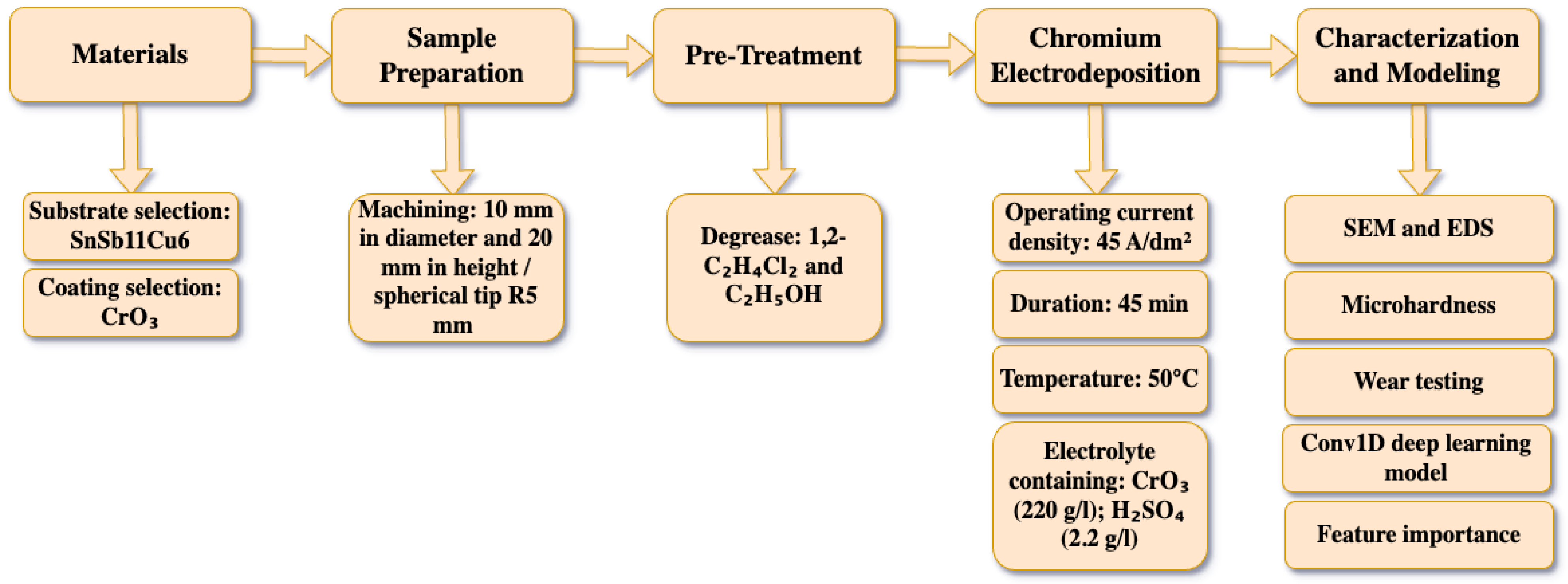
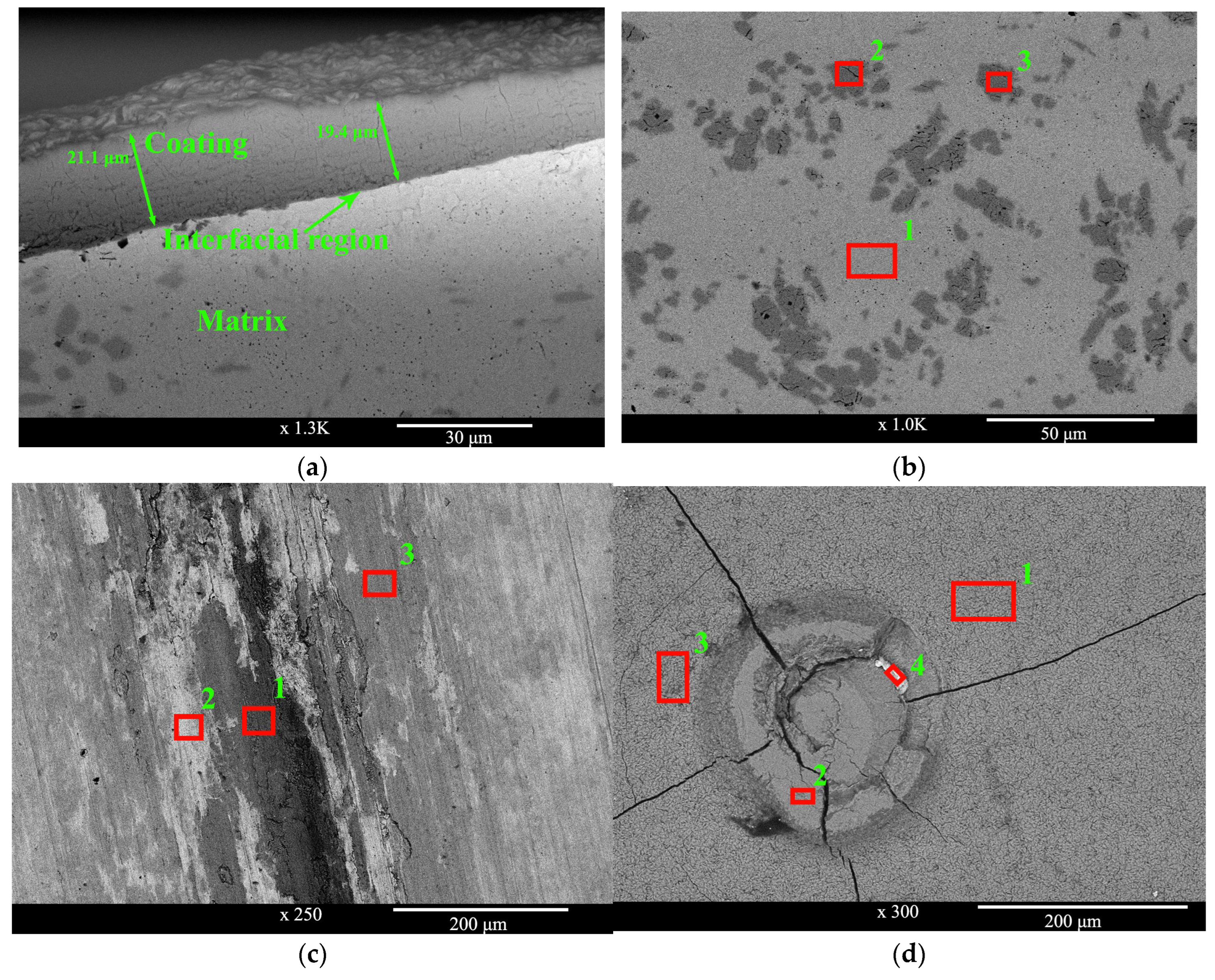
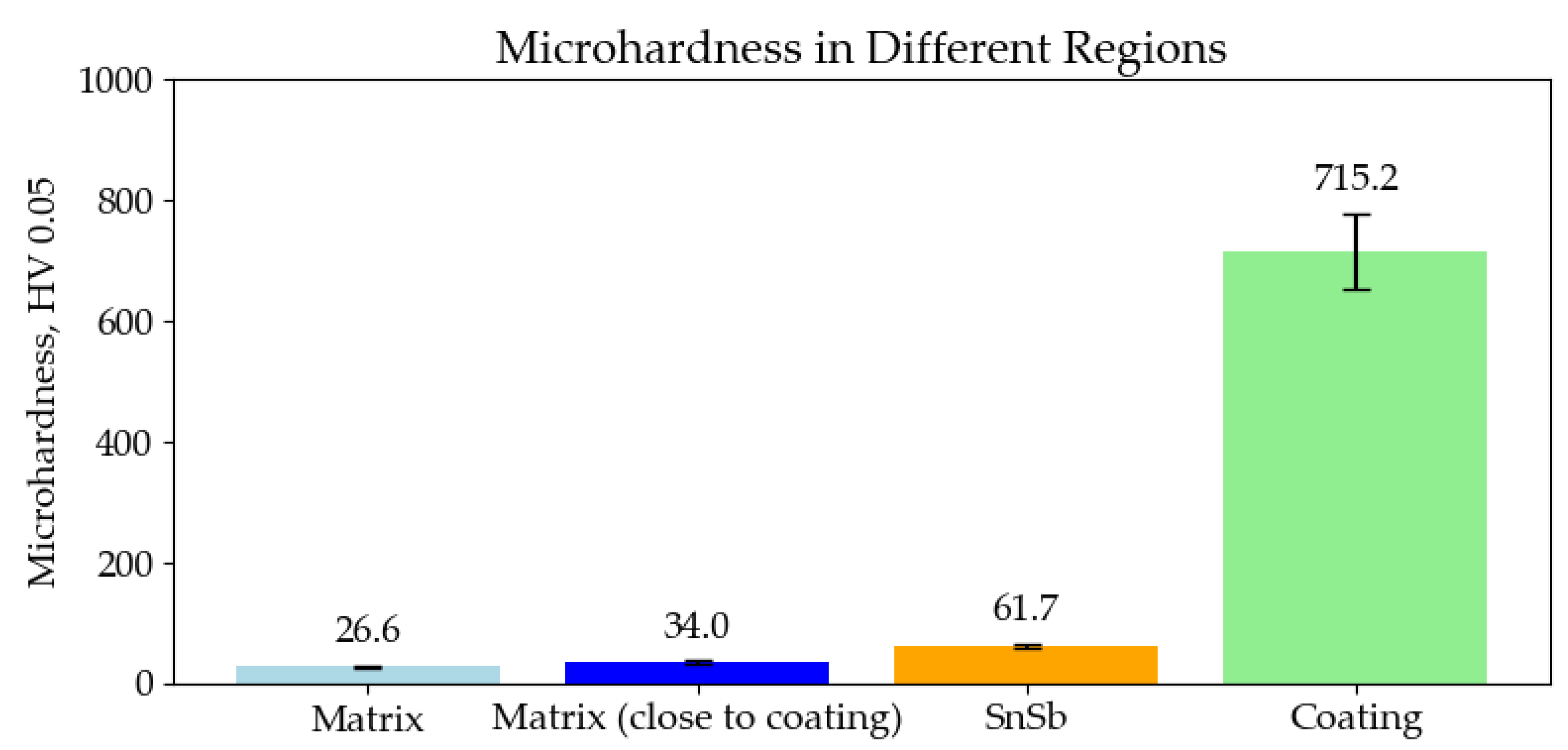


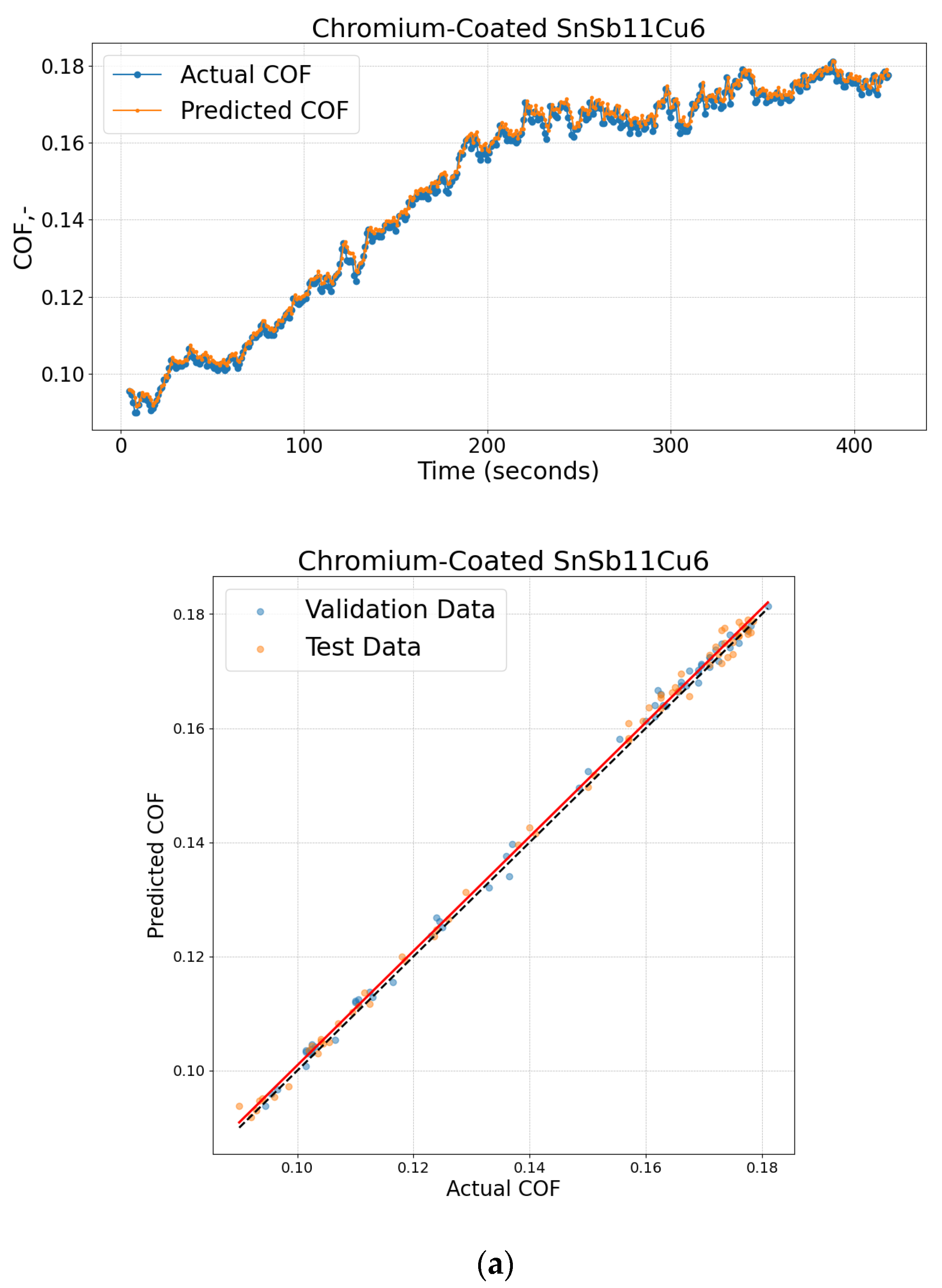
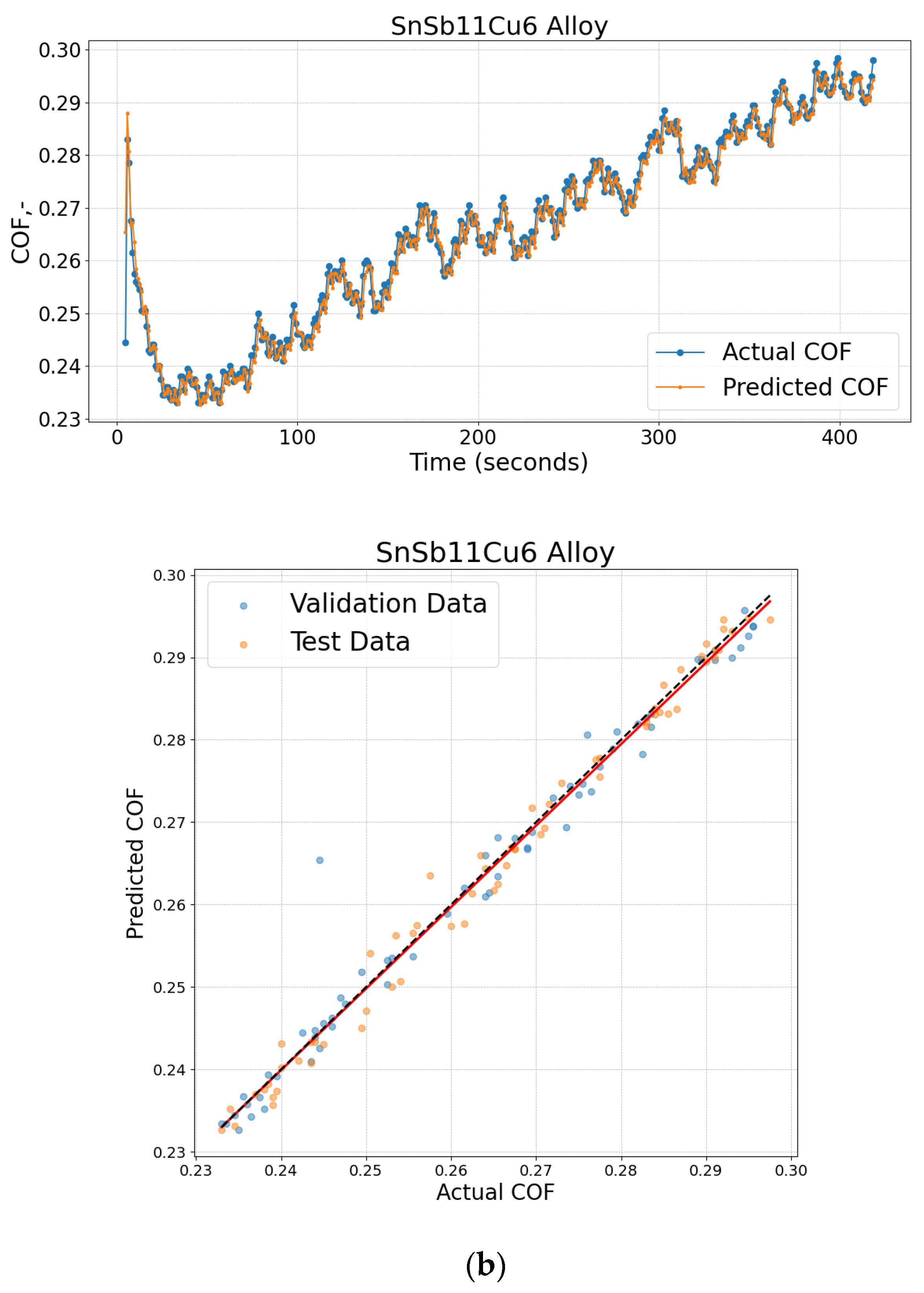
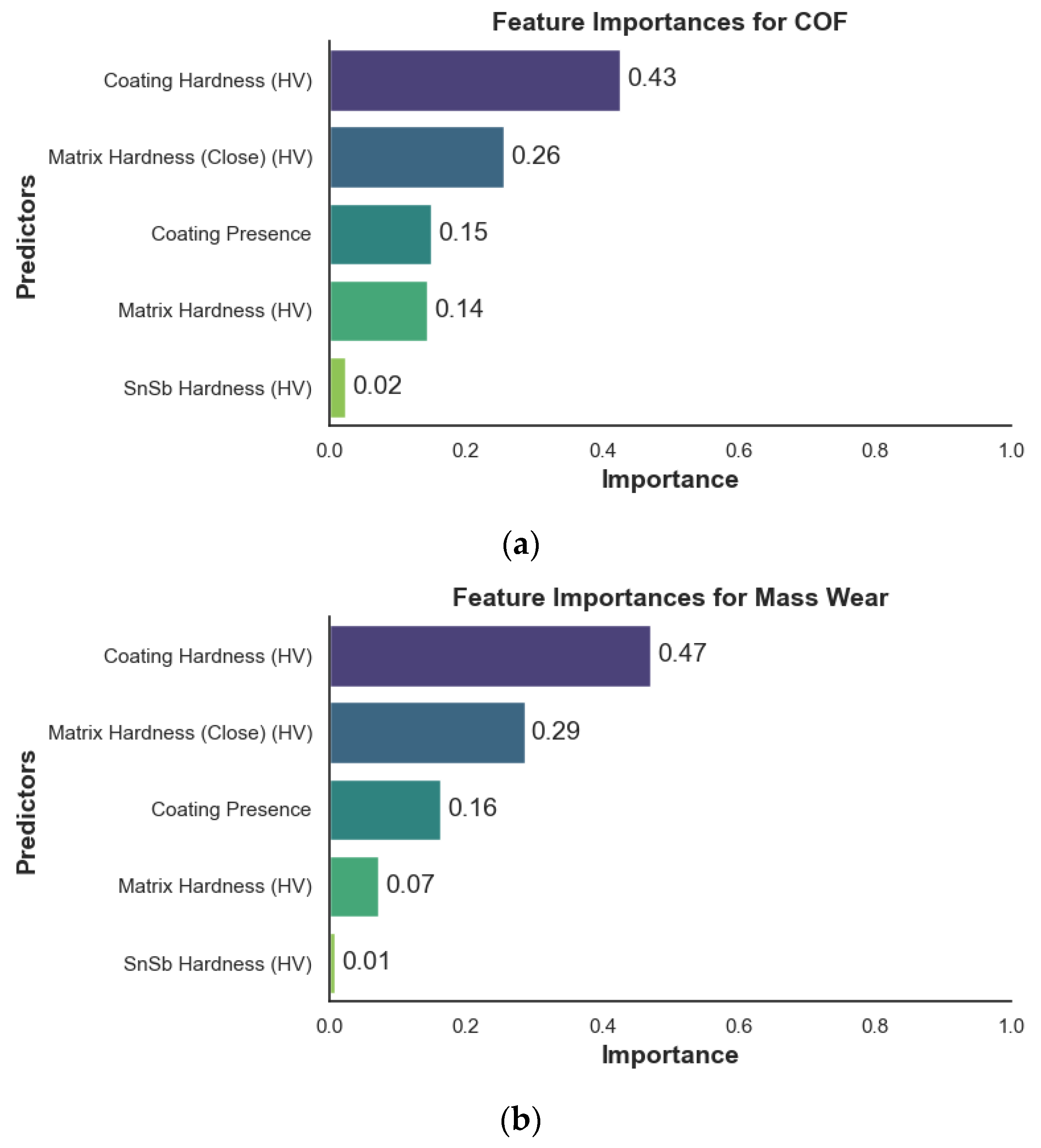
| Specimen | Analysis № | Sn | Sb | Cu | Cr | O | Fe |
|---|---|---|---|---|---|---|---|
| Surface morphology of the SnSb11Cu6 alloy before the wear test (Figure 2b) | 1 | 92.11 | 7.89 | - | - | - | - |
| 2 | 64.63 | - | 35.37 | - | - | - | |
| 3 | 65.21 | - | 34.79 | - | - | - | |
| Surface morphology of the SnSb11Cu6 alloy after the wear test (Figure 2c) | 1 | 62.22 | 8.62 | 2.45 | - | - | 26.72 |
| 2 | 88.97 | 11.03 | - | - | - | - | |
| 3 | 75.34 | 10.16 | 5.21 | - | - | 9.28 | |
| Surface morphology of the chromium-coated SnSb11Cu6 alloy after the wear test (Figure 2d) | 1 | - | - | - | 95.80 | 4.20 | - |
| 2 | - | - | - | 95.55 | 4.45 | - | |
| 3 | - | - | - | 95.20 | 4.80 | - | |
| 4 | 15.75 | - | - | 79.85 | 4.40 | - |
| Metric | Chromium-Coated SnSb11Cu6 Alloy | SnSb11Cu6 Alloy |
|---|---|---|
| Validation MSE Validation RMSE | 2.58 × 10−6 | 1.02 × 10−5 |
| 0.0016 | 0.0032 | |
| Validation MAE Validation R2 | 0.0013 | 0.0018 |
| 0.9971 | 0.9742 | |
| Test MSE | 3.15 × 10−6 | 4.31 × 10−6 |
| Test RMSE | 0.0018 | 0.0021 |
| Test MAE | 0.0014 | 0.0017 |
| Test R2 | 0.9968 | 0.9887 |
Disclaimer/Publisher’s Note: The statements, opinions and data contained in all publications are solely those of the individual author(s) and contributor(s) and not of MDPI and/or the editor(s). MDPI and/or the editor(s) disclaim responsibility for any injury to people or property resulting from any ideas, methods, instructions or products referred to in the content. |
© 2025 by the authors. Licensee MDPI, Basel, Switzerland. This article is an open access article distributed under the terms and conditions of the Creative Commons Attribution (CC BY) license (https://creativecommons.org/licenses/by/4.0/).
Share and Cite
Kolev, M.; Petkov, V.; Petkov, V.; Dimitrova, R.; Uzun, S.; Krastev, B. Wear Characterization and Coefficient of Friction Prediction Using a Convolutional Neural Network Model for Chromium-Coated SnSb11Cu6 Alloy. Lubricants 2025, 13, 200. https://doi.org/10.3390/lubricants13050200
Kolev M, Petkov V, Petkov V, Dimitrova R, Uzun S, Krastev B. Wear Characterization and Coefficient of Friction Prediction Using a Convolutional Neural Network Model for Chromium-Coated SnSb11Cu6 Alloy. Lubricants. 2025; 13(5):200. https://doi.org/10.3390/lubricants13050200
Chicago/Turabian StyleKolev, Mihail, Vladimir Petkov, Veselin Petkov, Rositza Dimitrova, Shaban Uzun, and Boyko Krastev. 2025. "Wear Characterization and Coefficient of Friction Prediction Using a Convolutional Neural Network Model for Chromium-Coated SnSb11Cu6 Alloy" Lubricants 13, no. 5: 200. https://doi.org/10.3390/lubricants13050200
APA StyleKolev, M., Petkov, V., Petkov, V., Dimitrova, R., Uzun, S., & Krastev, B. (2025). Wear Characterization and Coefficient of Friction Prediction Using a Convolutional Neural Network Model for Chromium-Coated SnSb11Cu6 Alloy. Lubricants, 13(5), 200. https://doi.org/10.3390/lubricants13050200






